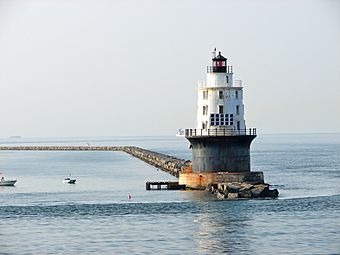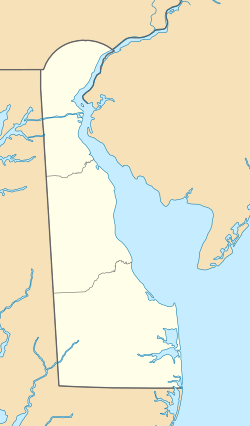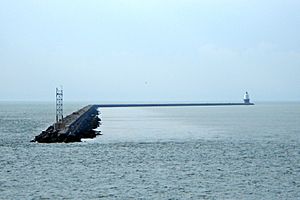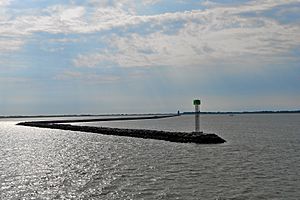National Harbor of Refuge and Delaware Breakwater Harbor Historic District facts for kids
Quick facts for kids |
|
|
National Harbor of Refuge and Delaware Breakwater Harbor Historic District
|
|
 |
|
| Location | Mouth of Delaware Bay at Cape Henlopen, Lewes, Delaware |
|---|---|
| Architect | Strickland, William |
| NRHP reference No. | 89000289 |
| Added to NRHP | March 27, 1989 |
The National Harbor of Refuge and Delaware Breakwater Historic District is a special area in Delaware. It includes a series of large stone walls, called breakwaters. These walls were built between 1828 and 1898. Their main purpose was to create a safe place for ships to anchor. This was important because the coastline here did not have many natural safe harbors.
This historic district is mostly out in the water, near Lewes, Delaware. It's located where the Delaware Bay meets the Atlantic Ocean. Only a small part of it touches land, at a former United States Coast Guard station. In 1989, this area was added to the National Register of Historic Places. This means it's recognized as an important historical site.
Building the Delaware Breakwater
In 1822, the United States Congress (which makes laws for the country) decided to study if a safe harbor could be built at Cape Henlopen. A group of experts, including General Simon Bernard and Commodore William Bainbridge, looked into it. They suggested that a permanent harbor should be created.
In 1826, a designer named William Strickland started planning the breakwater. This would be the first breakwater of its kind in the Americas. It was also only the third in the world, after similar ones in France and England.
Work began in 1828 on what is now called the inner breakwater. This part is also listed on the National Register of Historic Places. The project included a main breakwater that was about 2,100-foot (640 m) long. There was also an icebreaker pier, about 1,700-foot (520 m) long. Both were built from rough granite stones. These stones came from New Castle County, Delaware, and some smaller ones from the Hudson Palisades. The breakwaters are 160 feet (49 m) wide at the bottom and 20 feet (6.1 m) wide at the top. The whole project used 835,000 tons of stone! Strickland also designed a lighthouse for the harbor, which was finished the next year.
The harbor worked well, but it soon became clear it was too small. During storms, as many as 200 ships would try to find safety there. Sand also started to build up, making parts of the harbor shallow. In 1877, a hurricane damaged several ships inside the harbor. Other ships couldn't even get in.
To fix these problems, work started in 1883 to close the gap between the icebreaker and the main breakwater. They used the same type of stone as before. This new work made Strickland's original lighthouse unnecessary. A new one, the Delaware Breakwater East End Light, replaced it in 1885. The project took a long time, 16 years. During this time, 70 sailors died in the Great Blizzard of 1888, a very severe snowstorm. The breakwater closure was finally finished in 1898.
An iron pier was also built starting in 1871 by the U.S. Army Corps of Engineers. It was completed in 1882. This 1,700-foot (520 m) pier was designed to let trains carry goods directly to ships in the harbor. The pier was built using iron "screw piles," which are like giant screws drilled into the seabed. Wooden planks covered the top. Later, the pier was used by the U.S. Lifesaving Station (which rescued people from shipwrecks) and a quarantine station (where ships were checked for diseases). Today, the iron shafts of the pier are still visible in the harbor. They are a danger to ships navigating the area.
The National Harbor of Refuge
In 1896, Congress approved a new, even bigger plan for breakwaters. This was called the National Harbor of Refuge. It was built about 6,500 feet (2,000 m) north of the first breakwater, on a shallow area called The Shears. This new breakwater used much larger stones. Some individual stones weighed up to 13 tons! The new breakwater was 8,040 feet (2,450 m) long at low tide and 40 feet (12 m) wide.
Ten icebreaker piers were also built about 1,250 feet (380 m) to the north, in a 1,300 feet (400 m) line. These were also made of cut stone. Compared to the earlier project, new steam-powered machines allowed workers to use bigger stones and build faster. This huge project cost over $2 million and was finished in 1901.
The first Harbor of Refuge Light was built on this new breakwater and started working in 1908. It was damaged by storms in 1920. The current lighthouse replaced it in 1926. This new light took over from the old Cape Henlopen Light, which was abandoned in 1924 and fell into the sea in 1926.
Coast Guard Station
The Lewes Coast Guard Station is now used as the Delaware River pilot's station. River pilots are experts who guide large ships safely through tricky waterways. The station building is a 2.5-story structure built in 1938. It's made of wood and designed in the Colonial Revival style, which looks like old American colonial homes.
The front of the building faces the harbor. It has an enclosed porch with pairs of Tuscan columns. The outside of the station is covered with shingle siding. On the roof, there's an enclosed observation deck. It has a special railing and windows on all sides, perfect for watching the harbor.





